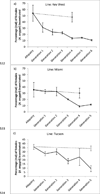Rapid evolution of reduced receptivity to interspecific mating in the dengue vector Aedes aegypti in response to satyrization by invasive Aedes albopictus
- PMID: 24563572
- PMCID: PMC3927939
- DOI: 10.1007/s10682-013-9669-4
Rapid evolution of reduced receptivity to interspecific mating in the dengue vector Aedes aegypti in response to satyrization by invasive Aedes albopictus
Abstract
In this paper we examine the effect of reproductive interference on the dynamics of two mosquito vectors of public health concern and add to the growing literature on the strength and speed with which interspecific reproductive interference may drive evolution. Recent evidence supports a role for asymmetric reproductive interference, or satyrization, in competitive displacements of Aedes aegypti by Aedes albopictus. However, populations of A. aegypti sympatric with A. albopictus in nature evolve resistance to satyrization. Here we report that A. aegypti from Tucson, Arizona (USA), where A. albopictus are not known to occur, are satyrization-susceptible. Furthermore, in cage experiments we demonstrate rapid evolution in satyrization-susceptible lines. Exposing allopatric strains of A. aegypti to A. albopictus in cages led to significant reductions, within 1-3 generations, in the frequency of reproductive interference. We also demonstrate that satyrization-resistant A. aegypti females derived from selection experiments are significantly slower to mate with conspecific males, suggesting a cost for the evolution of satyrization-resistance. Results show how interspecific interactions between these vector species are rapidly evolving, with implications for the arboviral diseases, especially dengue and chikungunya, which they transmit.
Keywords: Aedes; interspecific mating; rapid evolution; satyrization.
Figures
Similar articles
-
Demonstration of resistance to satyrization behavior in Aedes aegypti from La Réunion island.Parasite. 2020;27:22. doi: 10.1051/parasite/2020020. Epub 2020 Apr 7. Parasite. 2020. PMID: 32254018 Free PMC article.
-
Satyrization and satyrization-resistance in competitive displacements of invasive mosquito species.Insect Sci. 2016 Apr;23(2):162-74. doi: 10.1111/1744-7917.12291. Epub 2016 Jan 18. Insect Sci. 2016. PMID: 26542083 Review.
-
Rapid Loss of Resistance to Satyrization in Invasive Mosquitoes and the Effects of Age on Interspecific Mating Frequency.J Med Entomol. 2019 Feb 25;56(2):329-333. doi: 10.1093/jme/tjy153. J Med Entomol. 2019. PMID: 30668807
-
Evolution of resistance to satyrization through reproductive character displacement in populations of invasive dengue vectors.Proc Natl Acad Sci U S A. 2013 Feb 19;110(8):2888-92. doi: 10.1073/pnas.1219599110. Epub 2013 Jan 28. Proc Natl Acad Sci U S A. 2013. PMID: 23359710 Free PMC article.
-
The Importance of Interspecific Interactions on the Present Range of the Invasive Mosquito Aedes albopictus (Diptera: Culicidae) and Persistence of Resident Container Species in the United States.J Med Entomol. 2016 Sep;53(5):992-1001. doi: 10.1093/jme/tjw095. Epub 2016 Jun 28. J Med Entomol. 2016. PMID: 27354436 Review.
Cited by
-
The Effects of Interspecific Courtship on the Mating Success of Aedes aegypti and Aedes albopictus (Diptera: Culicidae) Males.Ann Entomol Soc Am. 2015 Jul;108(4):513-518. doi: 10.1093/aesa/sav037. Epub 2015 May 5. Ann Entomol Soc Am. 2015. PMID: 27418696 Free PMC article.
-
Aedes aegypti Males as Vehicles for Insecticide Delivery.Insects. 2019 Aug 1;10(8):230. doi: 10.3390/insects10080230. Insects. 2019. PMID: 31374806 Free PMC article.
-
Interspecific mating bias may drive Aedes albopictus displacement of Aedes aegypti during its range expansion.PNAS Nexus. 2022 Apr 14;1(2):pgac041. doi: 10.1093/pnasnexus/pgac041. eCollection 2022 May. PNAS Nexus. 2022. PMID: 35601361 Free PMC article.
-
Demonstration of resistance to satyrization behavior in Aedes aegypti from La Réunion island.Parasite. 2020;27:22. doi: 10.1051/parasite/2020020. Epub 2020 Apr 7. Parasite. 2020. PMID: 32254018 Free PMC article.
-
Laboratory colonization of the European invasive mosquito Aedes (Finlaya) koreicus.Parasit Vectors. 2017 Feb 10;10(1):74. doi: 10.1186/s13071-017-2010-2. Parasit Vectors. 2017. PMID: 28183328 Free PMC article.
References
-
- Bequeart J. Aedes aegypti, the yellow fever mosquito, in Arizona. Bull Brooklyn Entomol Soc. 1946;41:157.
-
- Black WC, IV, Bennett KE, Gorrochótegui-Escalante N, et al. Flavivirus susceptibility in Aedes aegypti. Arch Med Res. 2002;33:379–388. - PubMed
Grants and funding
LinkOut - more resources
Full Text Sources
Other Literature Sources

